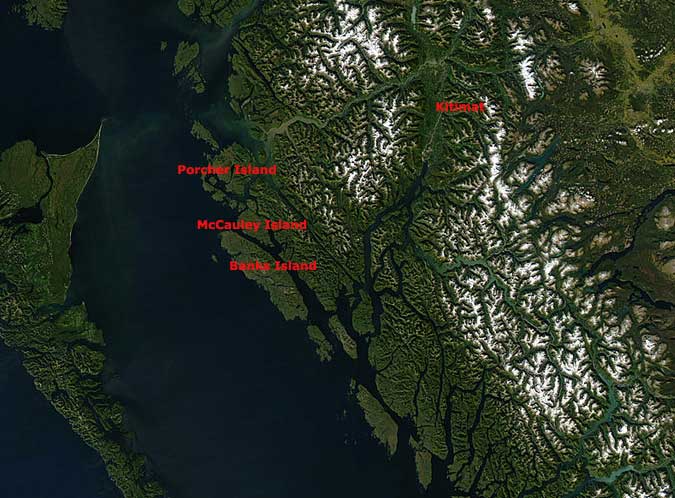Updated with Alterra comments.
![]() A Vancouver-based energy company, Alterra Power Corp, today, May 18, 2012, announced the acquisition of three wind farm sites off the northernwestern British Columbia coast.
A Vancouver-based energy company, Alterra Power Corp, today, May 18, 2012, announced the acquisition of three wind farm sites off the northernwestern British Columbia coast.
A news release from Alterra notes that the three “early-stage wind farm” sites, on Banks Island, Porcher Island and McCauley Island are “all within 150 kilometres of several proposed power-intensive LNG plant sites at Kitimat.”
The three sites plus one on Vancouver island will have an estimated generation capacity of over 1,000 megawatts for the four sites.
Alterra acquired the sites from English Bay Energy Limited. Alterra says “the sellers will receive royalty payments during the operations phase of the projects, and under certain circumstances the sellers may receive additional compensation of up to 1.34 million Alterra shares.”
The release quotes John Carson, Alterra’s Chief Executive Officer, as saying, “This transaction further positions us to play a major role in B.C.’s clean energy future. We look forward to advancing and ultimately building these wind projects as a part of the continued growth of Alterra and British Columbia.”

When informed of the announcement, Kitimat mayor Joanne Monaghan asked, “How are they going to get it here?”
While the three islands are within 150 kilometres of Kitmat, any transmission lines would have to somehow cross the Inside Passage and its heavy ship traffic, including cruise ships, ferries, fishing vessels and bulk carriers (not to mention potentially tankers), and then also get over some of the most rugged mountain territory in Canada to reach any of the three liquified natural gas sites in Kitimat.
“I know that all of the LNG plants considering coming in here, including Shell, are talking about co-gen [co-generation of electricity using natural gas], because if they don’t do co-generation they’re going to have to bring all of this in from the Site C Dam and that is going to make it totally out of the range of their price,” Monaghan said. She also remarked that the cost of building transmission lines from the three off shore islands could also be prohibitive.
Alterra spokesman Anders Kruus said that supplying power from the islands to Kitimat a major consideration but added it “would not be an insurmountable problem.”
He said the company’s predecessor before a merger, Plutonic Power, had built “the province’s largest run-of-river hydro facility at Toba Inlet not far from Powell River (80 kilometres) and in the process of building that, beause the run-of-river facilty was quite far back, not accessible by roadway, you have to barge in, we built a 120 kilmetre long tranmission line out to Saltery Bay. So we’ve done it over the mountains.” Kruus said.
“It’s early days,” Kruus said and the company now plans to compile more wind data before proceeding. He acknowledged that the “intermittency of the wind” could be a problem with an LNG plant that requires a consistent, balanced power load and so the best “off-taker” (customer) for the wind energy electricity might likely be BC Hydro who could balance the power from the project within its own system before supplying it to customers.
On its website, Alterra Power Corp describes itself as
a leading global renewable energy company, formed in 2011 through the merger of Magma Energy Corp and Plutonic Power Corp. We operate six power plants totaling 570 MW of capacity, including two geothermal facilities in Iceland, a geothermal plant in Nevada, British Columbia’s largest run of river hydro facilities and the province’s largest wind farm. Our 300 MW share of production generates over 1,400 GWh of clean power annually. We have an extensive portfolio of exploration and development projects, a skilled international team of explorers, builders and operators as well as the strong financial capacity to support our aggressive growth plans.